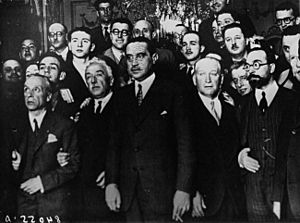First Biennium facts for kids
The First Biennium was an important time in Spain's history. It is also known as the Social-Azañist Biennium or the Reformist Biennium. This period lasted from April 14, 1931, when the Second Spanish Republic was declared, until the general election in 1933. It was a time of big changes and new ideas for Spain.
Contents
Starting the Republic (April–December 1931)

After the Republic was declared, a group called the Provisional Government took charge. This government led Spain until December 15, 1931. That's when the first permanent government was formed, just six days after the new 1931 Spanish Constitution was approved.
At first, Niceto Alcalá-Zamora was the leader of the Provisional Government. But he disagreed strongly with Article 26 of the Constitution. This article talked about religion in Spain. Because of his strong feelings, he resigned on October 15, 1931. After him, Manuel Azaña became the new leader.
A Time of Big Changes (December 1931 – September 1933)
On December 15, 1931, Manuel Azaña formed his second government. This government was made up of politicians from left-leaning parties. These included Republican Action, the Radical Socialist Republican Party, ORGA, and Republican Left of Catalonia.
Azaña wanted to make many big changes in Spain. These changes aimed to fix long-standing problems. These problems were often called "pending questions." They included issues with society, religion, farming, and the military. However, many groups in society and businesses did not like these changes. They felt the government was trying to take away their power and positions.
Why Azaña's Government Ended
Azaña's government was very popular in late 1932. It successfully stopped anarchist groups and defeated a rebellion by people who wanted the king back. The General Workers' Union, a large workers' group, supported the government. This was true even though another group, the CNT, was growing stronger. During this time, the Republic also made important changes to the military and public schools. They also started many large public building projects.
But by 1933, the government faced many challenges. They felt pressure from inside Spain and from other countries. The government's problems began with an anarchist uprising. This led to a sad event known as the Casas Viejas incident. This event made many people lose trust in the government. Along with this, Spain faced an economic downturn and more people lost their jobs. Also, a movement called National Catholicism grew stronger. Because of all these difficulties, Azaña decided to resign as President of the Republic.
See also
 In Spanish: Primer bienio de la Segunda República Española para niños
In Spanish: Primer bienio de la Segunda República Española para niños

